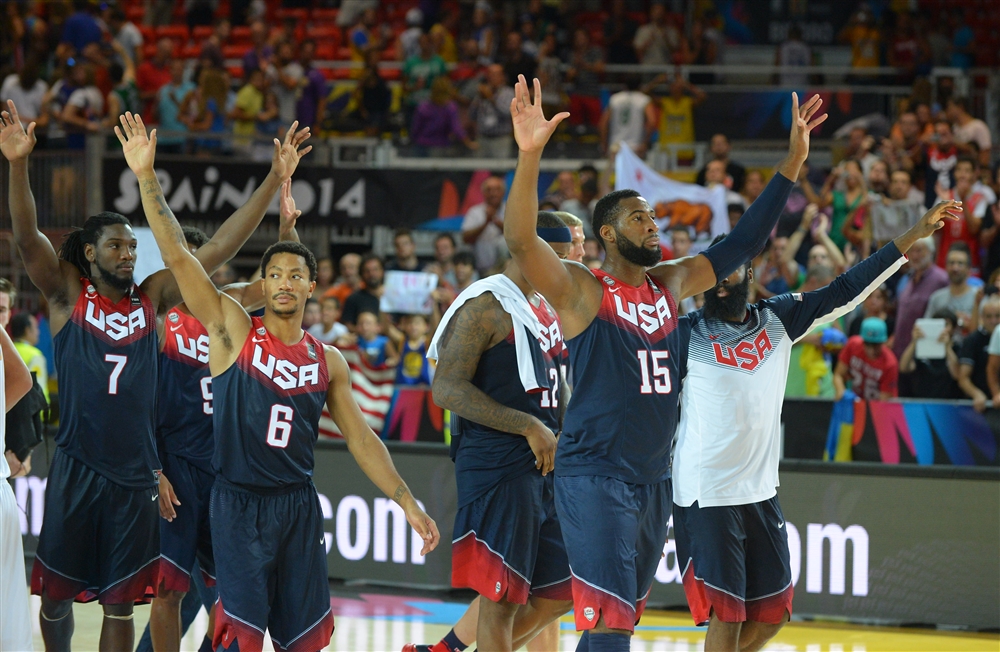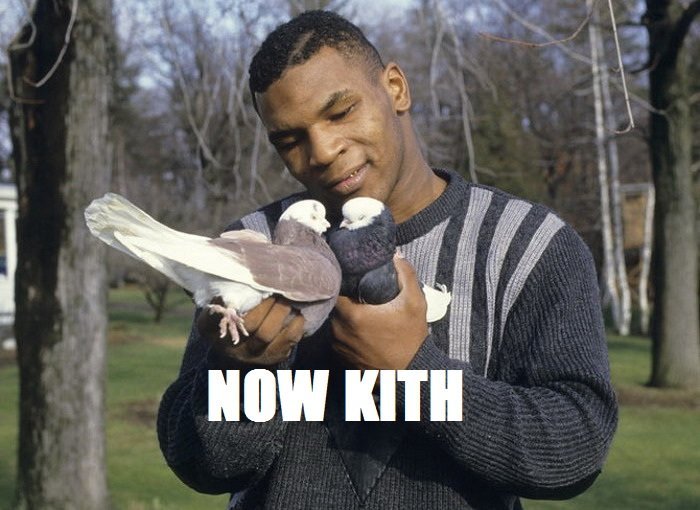Last season, the Toronto Raptors posted a top-1o defense for the first time in a decade.
Much of the credit goes to head coach Dwane Casey — a reputed defense-first coach — for finally getting through to his squad. His mandate over the past three seasons has consistently centered around building a sound defense, but he was betrayed by his players. Last season, having finally shed defensive sieves like Jose Calderon and Andrea Bargnani, Casey’s vision of a strong defensive club finally came to fruition.
Like most coaches, Casey’s defensive scheme centers around a defensive anchor. In Minnesota, Casey had Kevin Garnett. As an assistant in Dallas, Casey had Tyson Chandler. Casey doesn’t have a Chandler or Garnett-type in Toronto. He only has an overworked Amir Johnson and a 22-year-old Jonas Valanciunas. If the Raptors are to improve into becoming an elite defensive club, it will have to come on the backs of young Jonas.
My first article on Raptors Republic was a wordy 2,500 article on Valanciunas’ rookie season. I profiled his defense, and found that like most rookies, Valanciunas struggled. His size was the culprit, as he lacked the strength to contend with centers in the post (example 1, example 2.) On the whole, Valanciunas was a poor defender at a pivotal position, and his shortcomings significantly factored into the Raptors’ 22nd-ranked defense.
In an effort to improve as a post defender, Valanciunas bulked up last summer. As Zach Harper of CBS Sports observed, Valanciunas looked 15-to-25 pounds heavier at Summer League. The most obvious result of the added bulk came on the offensive end, as Valanciunas easily overpowered opponents in the post en route to a well-deserved Summer League MVP award.
The added size also factored in defensively. Valanciunas improved in guarding post-ups. Per Synergy Stats, Valanciunas ranked 55th in points allowed per post-up last season, a substantially better mark than his 145th ranking in his rookie season.
| Season | Usage | PPP | NBA Rank |
| 2013-14 | 45% | 0.75 | 55 |
| 2012-13 | 51% | 0.84 | 145 |
It’s still a stretch to call Valanciunas a strong post defender, but he’s improved to the point of being solid in that regard. In short, Valanciunas is massive and he doesn’t bite too often on fakes in the post. He does a great job of holding his ground, keeping his hands high, content in allowing opponents to tackle the challenge of finishing over a seven-foot giant.
[gfy]MemorableOrganicGoldfinch[/gfy]
In staying down in the post, Valanciunas trades blocks for contests. He averaged just 0.9 blocks per 36 minutes last season, but managed to hold opponents to 51.4 percent shooting at the rim, a mark good for 32nd in the NBA among players who faced over five attempts per game. That mark isn’t terrific, but ranks on par with the likes of Marc Gasol (51.2 percent) and Chris Bosh (53.1 percent.) He’s nowhere near Bosh and Gasol’s level defensively but his post defense at the rim was strong.
However, despite his improvements in the post, Valanciunas still doesn’t grade out as a good defender in most boxscore statistics. Notably, in ESPN’s Real Plus-Minus, Valanciunas ranked 64th out of 74 players that qualified as centers last season, thus saddling him with a ho-hum -0.48 Wins Above Replacement. Why didn’t his improved post-defense translate overall?
One theory is his that his lack of blocked shots hides his true value in a boxscore-based forumla. ESPN’s Real Plus-Minus formula is proprietary, so I can’t accurately comment on how it’s calculated, but the origin of RPM is said to follow in the lineage of Adjusted Plus-Minus, of which includes Regularized Adjusted Plus-Minus, which has a boxscore component. If so, a lack of blocks could be to blame, although the RPM leaderboard isn’t exactly filled with shot-blockers.
The more likely explanation traces back to how defenders attacked Valanciunas. As the season wore on, teams shifted their strategy, opting instead to play pick-and-pop against Valanciunas rather than attacking him in the post. Proportionally, Valanciunas faced 19 percent more spot-ups last season, with teams readily launching shots from outside the paint in an effort to lure Valanciunas out the the lane. However, the added bulk weighed Valanciunas down, thus making him slower on closeouts as compared to his rookie season, hence the spike in points per play (PPP).
| Season | Usage | PPP | NBA Rank |
| 2013-14 | 25.90% | 0.95 | 165 |
| 2012-13 | 21.70% | 0.81 | 38 |
To some degree, the increased emphasis on floor-stretching for bigs also played a factor, but opponents weren’t just launching from deep. Over 61 percent of spot-ups against Valanciunas were fired from two-point range. It largely came in response to the way Valanciunas was asked to guard pick-and-roll, dropping back to concede the jumper out of deference for a drive. In the play below, he gives Phoenix Suns forward Markieff Morris an open look after sagging back to hedge against a potential drive from Eric Bledsoe.
[gfy]DimBlueBrocketdeer[/gfy]
Conceding open looks from midrange is a trade-off Casey is willing to make in order to take away the drive, but making a concerted close-out is still important. To his credit, Valanciunas is willing to make the effort, but the added weight has slowed him down a step, thereby forcing him to leap a tad early on closeouts. All it usually took was one easy pump-fake to get Valanciunas off his feet on closeouts. He gets schooled in the clip below by Anderson Varejao, for example.
[gfy]LegitimateMadIndianelephant[/gfy]
Given the way Casey wants bigs to defend pick-and-rolls, Valanciunas will have to learn the balance between due-diligence and over-excitement on closeouts. As of right now, Valanciunas is too willing to leave his feet, something he doesn’t necessarily need to for most shooters. It’s contextual. Leaping at a knockdown three-point shooting big like Channing Frye makes perfect sense. Flying out against a sub-40 percent midrange shooter like Varejao doesn’t.
Finally, Valanciunas also made strides as a help-defender. He mostly stays rooted in the paint where he’s most comfortable, but he will leave the paint if his man isn’t the a threat to score. His help defense on the perimeter isn’t great because he lacks quickness, but he will make smart rotations near the rim because, quite frankly, that’s where he’s usually situated. In the play below, Valanciunas recognizes that the Thunder’s biggest threat is the Kevin Durant-Serge Ibaka pick-and-roll, so he leaves Steven Adams — who isn’t much of a threat to score — to help on Ibaka.
[gfy]WigglyUnacceptableIrishsetter[/gfy]
That being said, unless his quickness improves, Valanciunas will likely remain limited in a stay-at-home rim-protector role. With a (when healthy) rangy Amir Johnson by his side, Valanciunas’ limitations as a help defender is partially masked. He’s improved from being an awful defender in his rookie season to being decent as a sophomore.
But, in order for the Raptors’ defense to reach elite status, Valanciunas will have to continue to improve. That means sounder decision making and improved quickness while remaining strong in the post. It’s a lot to ask of a young player who is still feeling his way through the NBA game, but that’s the bind Valanciunas finds himself in. With the team’s core locked in for the foreseeable future, it’s up to players like himself and Terrence Ross to improve and therefore elevate the Raptors into a higher status as contenders.



